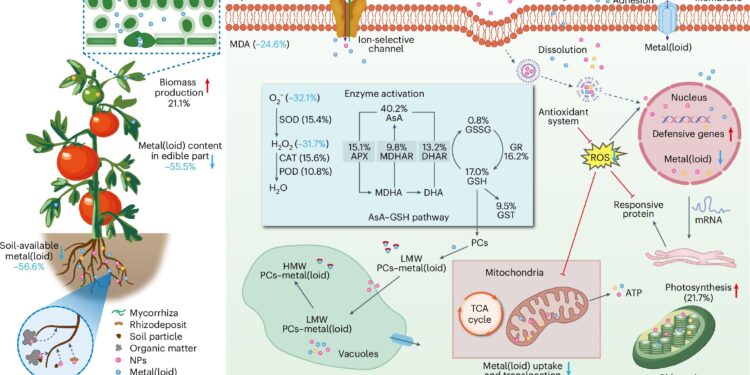Mechanisms of NM-mediated effects on metal(loid) uptake and translocation in soil-crop systems and defensive actions of plants against metal(loid) stresses. Credit: Natural food (2024). DOI: 10.1038/s43016-024-01063-1
One of the pressing issues facing the world in the era of climate change is how to produce enough healthy food to meet the world’s growing population, even as soil contamination increases. Research recently published in Natural food by an international team of scientists led by the University of Massachusetts Amherst, Guangdong University of Technology and the Central and South University of Forestry and Technology, showed that nanoscale nutrients can not only alleviate certain of the worst effects of heavy metals and metalloids. contamination, but increase crop yields and nutrient content.
“Much of the world’s arable soils are contaminated with heavy metals, such as cadmium, lead and mercury, as well as metalloids, such as arsenic and selenium,” says Baoshan Xing, professor emeritus at the university and director of the Stockbridge School of Agriculture at UMass Amherst.
Xing, who is also the lead author of the paper, notes that such contamination places significant stress on the ability to grow staple crops, which also affects the nutritional value of the crops that manage to survive.
“We need to find solutions to reduce the heavy metals that end up in our foods,” says Xing, and one approach that has shown promise is the use of nanoscale nutrients, or what he calls a “nano-activated” agriculture. .
The bulk fertilizers you may be more familiar with consist of large particles, which are not as easily absorbed by the crop. This means farmers have to apply more, increasing levels of fertilizer runoff into streams, lakes and the ocean. However, nanoscale crop nutrients can be specifically designed and mixed for particular crops, growing conditions and application methods, and designed in such a way that the target plant can most efficiently absorb the nutrients. nutrients into its system, thereby reducing the amount of fertilizer needed. reduce costs and limit runoff.
Although nanomaterials are already available in the agricultural market and there are numerous peer-reviewed scientific studies examining their effects on soil and crop growth, the research by Xing and colleagues represents the first comprehensive account of the effectiveness of nanomaterials as a class, with results that offer practical insights to help guide sustainable agriculture and global food security.
Map of sampling location and effects of NMs on metal (loid) accumulation and crop physiological responses. Credit: Natural food (2024). DOI: 10.1038/s43016-024-01063-1
“We collected data from 170 previous publications on the effectiveness of nanoparticles in reducing the absorption of heavy metals and metalloids,” says Chuanxin Ma, co-senior author of the paper, who completed his training doctoral degree at the Stockbridge School of Agriculture at UMass Amherst and is now a professor. at Guangdong University of Technology in China. “From these 170 papers, we collected 8,585 experimental observations on how plants respond to nanomaterials.”
The team then conducted a meta-analysis on this massive trove of data, running it through a series of machine learning models to quantify the effect of nanomaterials on crop growth and uptake of metals and metalloids. , before finally testing a flexible quantitative approach, known as the IVIF-TOPSIS-EW method, which can shed light on how to choose different types of nanomaterials under a range of realistic agricultural scenarios.
The results show that nanomaterials are more effective than conventional fertilizers in mitigating the harmful effects of polluted soils (by 38.3%), can improve crop yields (by 22.8%) and the nutritional value of these crops ( by 30%), as well as fight against plant stress (by 21.6%) due to metallic and metalloid pollution. Nanomaterials also help increase soil enzymes and organic carbon, both of which help boost soil fertility.
“Of course, nanomaterials are not a silver bullet,” says Xing. “They must be applied separately depending on the crop and soil.”
That’s where the team’s IVIF-TOPSIS-EW method comes in.
“Our method can help policymakers choose the best course of action for their particular situation,” says Ma.
More information:
Yini Cao et al, Engineered nanomaterials reduce metal(loid) accumulation and improve staple food production for sustainable agriculture, Natural food (2024). DOI: 10.1038/s43016-024-01063-1
Provided by University of Massachusetts Amherst
Quote: Nanonutrients can mitigate the effects of soil contamination and increase crop yields (October 15, 2024) retrieved October 15, 2024 from
This document is subject to copyright. Except for fair use for private study or research purposes, no part may be reproduced without written permission. The content is provided for informational purposes only.



